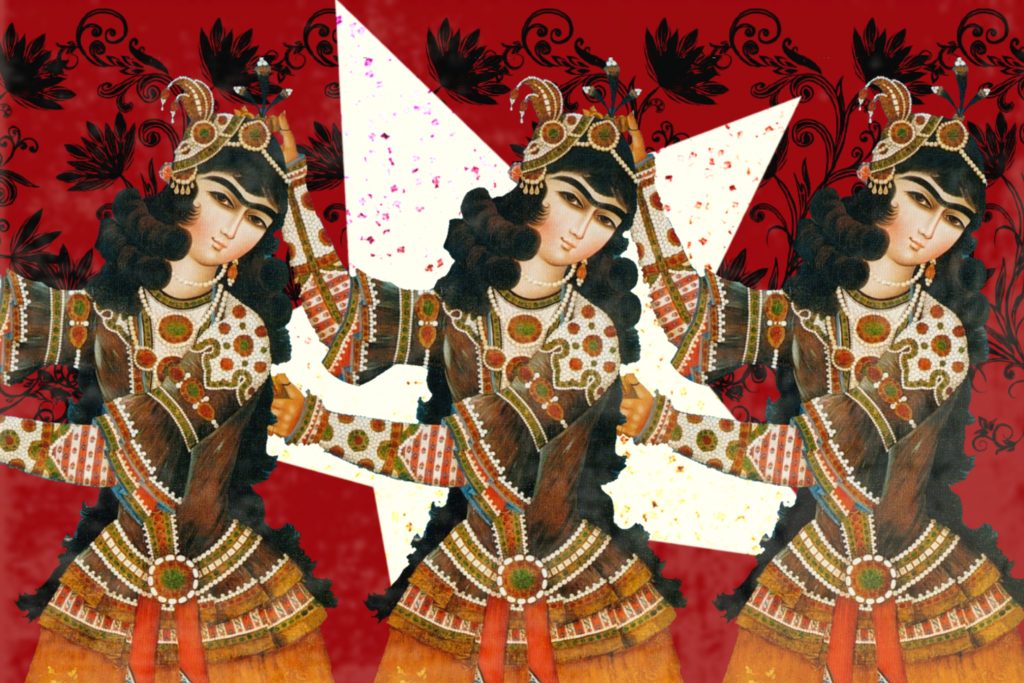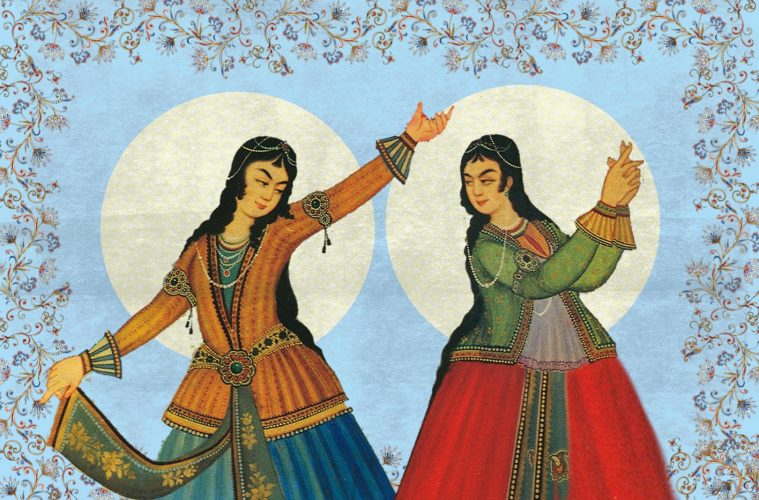Article by Karar Ahmed
Design by Lina A.
Translated by Hiba Moustafa
This article is part of the “Ya Leil Ya Eyein” issue
Persian dance is an oriental art that has taken form over thousands of years recording the history of kingdoms and empires in Persia. It is a pillar of Persian culture rooted in society that remains despite the prohibitions imposed by the government formed following the 1979 Iranian Revolution led by Ayatollah Khomeia. Even during the most difficult times, dance has always been a substantial social phenomenon for the nation.
It’s easy to be swept up in exploring and tracing the history of Persian dance and its many transformations. According to Nima Kiann, the origins of Persian dance as an independent and unique artistic form date back to the emergence of Mithraism, when ancient Persia enjoyed flexibility in terms of gender roles when it came to dancing. Courts did not only have female dancers, but male ones too, men and boys alike.
This article traces the major transformations Persian dance has witnessed over the years, from the Qajar dynasty to the Pahlavi dynasty to modern Iran, and examines how dance has affected and been affected by government policies.
The Qajar Dynasty
The Qajar dynasty, which ruled Persia for almost two centuries – from 1779 to 1925, has had a huge influence on the current form of Persian dance. The Qajar sowed the seeds of Persian classical dance, particularly during the reign of Fath-Ali Shah who allocated a large part of the royal treasury to supporting all forms of art, including dance. The thing that distinguishes Persian dance is its focus on sensual expression through face and hands; to express feelings during a dance is what gives it a true Persian style. Male and female dancers focus on their various facial expressions, coordinating mouths and eyebrows along with intricate finger and shoulder movements. The audience observes the male or female dancer with coquettish, flirtatious looks and with pride, joy, laughter, lustfulness and sadness. It’s as if dancers’ torsos seem to paint a scene. The Qajar, more than any preceding dynasty that ruled Iran, managed to make dance a popular social phenomenon. There are illustrations of Persian dance majlis, which Iranians celebrate today as a contemporary artistic form that describes Iranian life between modernity and cultural heritage. One can find these illustrations on murals and clothes and even in the symbols of political protest.

Design by Lina A.
Pahlavi Dynasty
Following the Qajar dynasty and with the Pahlavi line’s ascension to power, the country’s attention was systematically turned to Western arts. Mohammad Reza Pahlavi, son of the founder of the Pahlavi dynasty, aimed to force the country to become “more modern” by imposing European architecture and lifestyle on the Iranian society. The local focus shifted from dancers in long-sleeved dresses to classical ballet.
Choreography was nevertheless inspired by Persian culture. In the late 1920s, ballet schools started to emerge and train Iranian youth in dance. In 1947, Nilla Cram Cook, the former director general of Ministry of Education’s Arts Department who had an extensive knowledge of Eastern cultures and was attached to Iranian culture, founded a dance group that aimed to design dance styles inspired by Iranian literature, poetry, and folklore traditions that communicated folk stories and myths. Cook named the company The Revival of the Iranian Classical Arts. Active until 1953, it was the first professional ballet company and toured nationally and internationally, mostly in the Middle East.
The country exhibited tolerance of men’s dancing – evidenced by government programs and interviews – until conservatives came to power. Despite lack of government interest in folk dances, a new type of recreational dance emerged in the mid-20th century, one that was rooted in the Qajar Empire’s traditions but in an improvised and unique form. However, it didn’t become popular until the emergence of Iranian cinema, when it developed into multiple forms including the Baba Karam dance.
After the Islamic Revolution came to power, dance was seen as a punishable sin. Participating in or promoting dance is punishable by up to several months, fines and flogging, and all dance groups were disbanded and their members immigrated abroad. Teaching dance is also prohibited in Iran.
The Islamic Revolution caused a mass exodus of Iranian dancers, who fled to various parts of the world for fear of the regime. But because dance will continue to be present even in the most acute crises, those interested in dance in the Iranian diaspora have developed their dances and brought some to Iran. Mohammad Khordadian is one of them. Khordadian revolutionized Persian dance from abroad through his videotapes that were smuggled to Iran. Every Iranian family knows him, circulating videos of his dances among them for learning purposes.
Meanwhile, the government imposed strict censorship. Khordadian, based in LA, was arrested when he returned to Iran for a family visit more than twenty years after his departure. He spent 21 days in solitary confinement and 40 days in the infamous Evin Prison. He was convicted on charge of “promoting depravity and corruption among the youth” through his dance videotapes. His 10-year prison sentence was later suspended, but he was barred from giving dance lessons for life. This shows the Iranian regime’s strictness in imposing restrictions on arts.
Dancing Is Not A Crime
The #DancingIsNotACrime hashtag (or رقصیدن_جرم_نیست in Persian) sparked outrage following the arrest of Maedeh Hojabri, who was arrested for posting videos of herself dancing to Iranian and foreign songs. In a clip aired by national TV after Hojabri’s release, she apologized for her “bad manners” and committing an “indecent act” in a show of religious publicity practiced in Iran to impose authority and discipline women. In 2014, seven young men and women were arrested after posting a video of their dancing to “Happy” and were sentenced to imprisonment and flogging.
On Twitter, videos of solidarity with Hojabri formed a part of the resistance Iranian women show in their conflict with the fundamentalist government. The defamation attempt backfired and Hojabri became a face for the movement against arbitrary arrests Iranian women face.
The dance challenge then spread to the rest of the world by both Iranians and sympathizers. In London, Amnesty International staff made a video to spread the news and Iranians kept dancing and posting videos despite the government prohibition.
Dancing in the Time of COVID
In increasingly difficult times brought on by the spread of the COVID pandemic, nurses and physicians in hospitals were under extreme pressure. As the frontline workers faced a catastrophic number of cases in the ongoing pandemic in Iran, medical staff tried to create a different atmosphere to reduce the severe psychological impact of the crisis through dance. They appeared in short videos, widely shared on social media, wearing masks and gloves and dancing, men and women bringing smiles to the faces of everyone who saw them. Despite some opposition, Tweeters generally reacted positively to these videos.
Group and individual dance on Twitter swept public opinion and invaded every home. Unlike previous instances of public dance, authorities did nothing, both because they knew that these videos have been important in addressing this crisis and because they couldn’t identify these people due to their protective clothes.
Persian dance has taken form throughout successive governments, which influenced and were influenced by it, and continues to be an act of political defiance that survives oppression. In every “dance challenge,” these videos show what dance can possibly mean. It will continue to exist even in the darkest of times.

